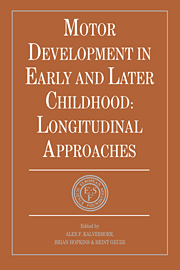Book contents
- Frontmatter
- Contents
- List of contributors
- Foreword
- Preface
- SETTING THE SCENE
- SECTION I BIOLOGICAL BASIS OF MOTOR DEVELOPMENT
- 3 Principles of early motor development in the human
- 4 Natural priorities for developmental study: neuroembryological perspectives of motor development
- 5 The ‘fixed action pattern’ concept revisited: an ethological commentary on the chapters by Prechtl and Provine
- SECTION II DEVELOPMENT OF BODY POSTURE AND GOAL-DIRECTED REACHING
- SECTION III MOTOR DEVELOPMENT, EARLY COMMUNICATION AND COGNITION
- SECTION IV ACQUISITION OF SKILLS
- SECTION V MOTOR DEVELOPMENT AND HANDICAP
- SECTION VI METHODOLOGICAL AND CONCEPTUAL CONSIDERATIONS
- Epilogue: description versus explanation
- Index
3 - Principles of early motor development in the human
from SECTION I - BIOLOGICAL BASIS OF MOTOR DEVELOPMENT
Published online by Cambridge University Press: 05 May 2010
- Frontmatter
- Contents
- List of contributors
- Foreword
- Preface
- SETTING THE SCENE
- SECTION I BIOLOGICAL BASIS OF MOTOR DEVELOPMENT
- 3 Principles of early motor development in the human
- 4 Natural priorities for developmental study: neuroembryological perspectives of motor development
- 5 The ‘fixed action pattern’ concept revisited: an ethological commentary on the chapters by Prechtl and Provine
- SECTION II DEVELOPMENT OF BODY POSTURE AND GOAL-DIRECTED REACHING
- SECTION III MOTOR DEVELOPMENT, EARLY COMMUNICATION AND COGNITION
- SECTION IV ACQUISITION OF SKILLS
- SECTION V MOTOR DEVELOPMENT AND HANDICAP
- SECTION VI METHODOLOGICAL AND CONCEPTUAL CONSIDERATIONS
- Epilogue: description versus explanation
- Index
Summary
INTRODUCTION
When the development of motor patterns in normal or abnormal infants and children is studied longitudinally, such investigations are always carried out within a theoretical concept, which is sometimes made explicit. Often, however, which theories and views on development and neural functions are held by the authors can only be conjectured. Since the methods of investigation and interpretation of results are closely related to the theoretical frame of reference in which these studies are carried out, it is useful to review new findings on early motor development as they contain certain new aspects for the theoretical approach to longitudinal studies. This chapter deals with empirical and mostly longitudinally collected data within the framework of development neurology, and is restricted to early human development.
The build-up of a movement repertoire in the fetus
An excellent illustration of the above-mentioned importance of theoretical background is represented by the history of fetal studies. A scientific interest in fetal movements has existed for more than 100 years. Preyer, in his famous book Die spezielle Physiologie des Embryo (1885), reports that fetal movements can be heard with the stethoscope at 12 to 16 weeks of pregnancy, i.e. before fetal movements are felt by the expectant mother. His comparative studies of embryonic and fetal motility were very much in the mould of nineteenth century natural historians, but they led him to a full acceptance of spontaneous motor activity in the human fetus. This idea became lost for nearly a century, with the rapidly growing dominance of reflex theory.
- Type
- Chapter
- Information
- Motor Development in Early and Later ChildhoodLongitudinal Approaches, pp. 35 - 50Publisher: Cambridge University PressPrint publication year: 1993
- 17
- Cited by



